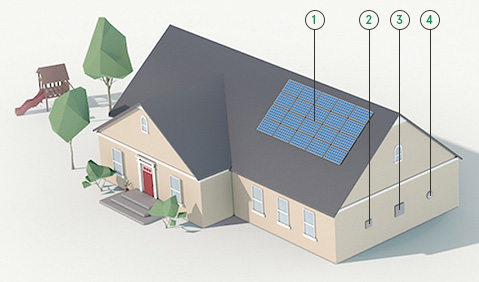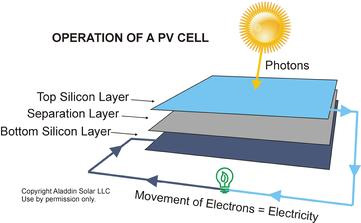How does sunlight become solar energy?
The solar power system takes energy from the sun and converts it to an inverter (Inverter) where energy is converted into electricity to be used for daily needs.
The image below will illustrate in detail how you see a solar system working?
1. Photovoltaic battery (PV) converts sunlight into direct current (DC)
2. Inverter converts DC current into AC current
3. The electrical system will send this alternating current to lamps and devices for use
4. Measures will calculate the energy you have consumed and respond to the grid

The solar power system converts sunlight into direct current, or the same form of electricity as in batteries where electric current only moves in one direction. Solar batteries, usually consisting of two layers of silicon (semiconductor material) and a layer of separation, are connected together and assembled into solar panels or modules.

When these batteries are exposed to sunlight, photons from the sun interact with electrons in the upper silicon layer, essentially knocking them out of the related atoms. Free electrons will be attracted to the atoms in the silicon layer below and into the wire to reach the other end. The movement of electrons from one side to the other side of the battery is the current. The term "photovoltaic" or PV is a unique description of this process.
When the solar system is produced, photovoltaic batteries are connected together into a series. The system's output voltage depends on the number of batteries that make up it. The output voltage is usually 12, 18 or 24 volts. The output power depends on the battery's efficiency and the size and area of each area on the battery in the system. The bigger the battery and the higher the efficiency, the bigger the capacity per square. Solar systems that use "genuine" batteries tend to be more expensive.
When the installer assembles a PV system, the exact number of connected panels (containing multiple batteries) in the series will be specified, to achieve the required voltage target. inverter or payload. After that, these panels will be connected "in parallel" to increase the capacity of the system. When all these components are installed, the sun provides energy and the system simply produces electricity.
Hopefully this article will help you more easily visualize how a solar power system works to get electricity from sunlight.
You should read it
- Is solar water heater heating water good?
- What is solar storm? How solar storm affects the Earth
- America must prepare 'carefully' for the Japanese Food Festival which will take place on August 21
- How is solar water heater structured, working?
- Turn urine into beer with solar energy
- Kvaern electronic bicycle can run on solar energy
 Play Mario with augmented reality technology right on the street
Play Mario with augmented reality technology right on the street Falcon Heavy - The world's most powerful super rocket can reach thrust of more than 2,300 tons
Falcon Heavy - The world's most powerful super rocket can reach thrust of more than 2,300 tons Magnetic cushion lifts: no cables are used, the first up, down, left, right in the world has appeared
Magnetic cushion lifts: no cables are used, the first up, down, left, right in the world has appeared Successfully decipher complex thoughts in the human brain
Successfully decipher complex thoughts in the human brain New coating helps supersonic aircraft withstand temperatures up to 3000 degrees Celsius
New coating helps supersonic aircraft withstand temperatures up to 3000 degrees Celsius 'Immediately teleport' photons into space
'Immediately teleport' photons into space